The edge of the world’s oceans is the shore, and it is continually modified by storm times. It comes and goes, builds and jettisons. In areas where rocky land masses dip directly into the sea, the shore may be less than two feet wide on average. Where more sand is delivered than taken away, the shore, then the beach, can be hundreds of feet wide. There is no surface geologic formation in the world longer than the shore.
Outdoors
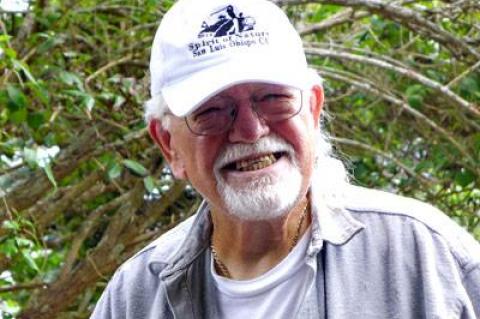 A World of Experience
A World of ExperienceKenny Bouse described how he and his brother began their fishing careers in Montauk 62 years ago this way:
“We took off from Bay Shore on an old ’51 flathead Harley. We didn’t know where the hell we were going. We got to the Lighthouse. I said, ‘What do we do now that the road stops.’ We found some Bubbies haulseining and they told us how to get to the docks.”
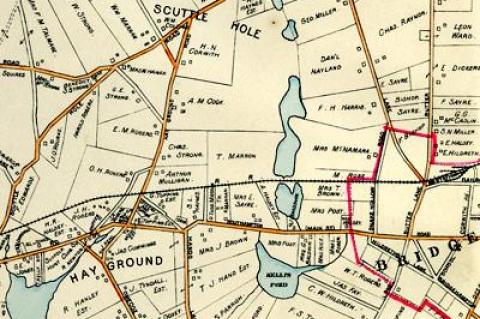 Nature Notes: Land of Ponds
Nature Notes: Land of PondsBefore I begin, I received an inquiry from Jim Monaco, a book publisher who lives in the south Sag Harbor hills, about deer and the underbrush. He has no ladyslippers, lilies, or other pretty flowers in the groundcover of his nearby woods, only huckleberries and blueberries. True, deer eat orchids, lilies, and other pretty flowers, as do rabbits, squirrels, and other wild beasties in our area.
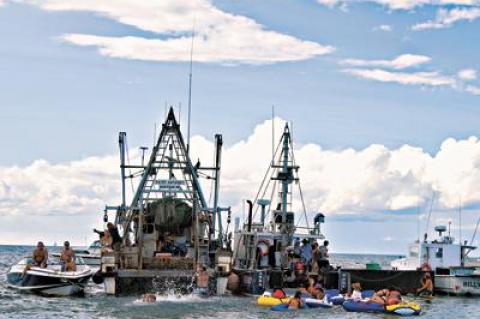 Fear and Great Joy
Fear and Great JoyThe party on the banks of Fort Pond Bay in Montauk Sunday celebrated the rescue of John Aldridge after his surviving 12 hours at sea over 30 miles offshore with the help of buoyant rubber boots. He was known as Johnny Load, a nickname with undefined coinage. He is now known as Johnny Boots.
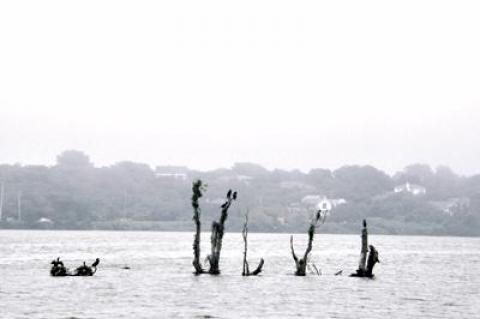 Nature Notes: The Rising Waters
Nature Notes: The Rising WatersThe water is rising. Well, not all over, but in many places locally. Chatfield’s Hole in East Hampton’s Northwest is well and good, having almost dried up last summer, as are all of the other ponds in that area — Staudinger’s, Crooked, Two Holes of Water, Scoy, Little Scoy. and Wood Duck Ponds. The quiet little pond that wants a name, just north of Swamp Road where it meets Two Holes of Water Road is so full that it now runneth over into Northwest Creek.
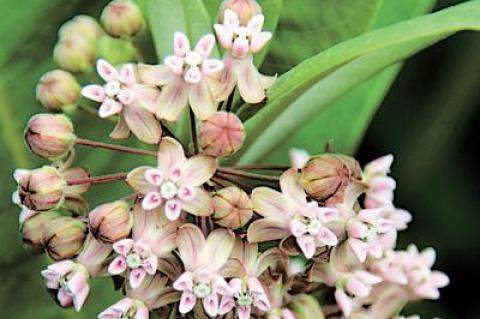 Nature Notes: Pick Your Poison
Nature Notes: Pick Your PoisonIt’s a jungle out there and I don’t mean New York City at night, I mean out there out here. Whether you walk in the woods or through an old field, try to catch a clam or two with your toes, or sit outside at night under the starry sky, at this time of year there is always something lurking, ready to unsettle you.
As you ride along some of our scenic routes where you used to be able to get a good look at the water, be it a pond water, the ocean, a bay, or a creek water, you will often find the view obscured by one of the world’s tallest grasses, the common reed, or phragmites. Linnaeus himself in the mid-1700s first described the reed and gave it its first scientific name, the binomen Arundo phragmites, one of thousands he created. Phragmites stems from the Greek for “growing in hedges,” and describes its tendency to form vegetative walls that block the view.
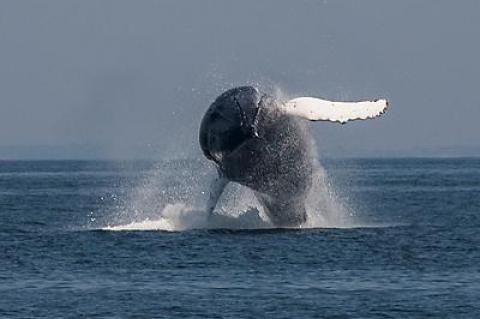 They Came to the Surface
They Came to the SurfaceIt’s likely we were put on this earth, or, depending on your point of view, we evolved on this earth, for no other reason than to bear witness. Homo sapiens seem to have no other meaningful purpose. From a global point of view, we tend to muddle things up when we act. Best to just keep our hands in our pockets and watch and, as a few East End witnesses did this past week, marvel.
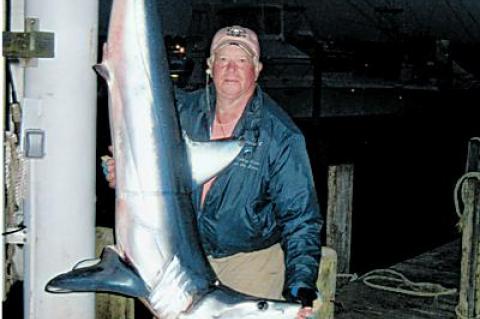 Catch Big, Release Tagged
Catch Big, Release TaggedAsked if it was true that the low number of boats signed up so far for the no-kill SharkEye tournament might cause it to be canceled, Carl Darenberg of the Montauk Marine Basin, which is hosting the event, said, “If we have 10 boats, it’s enough.”
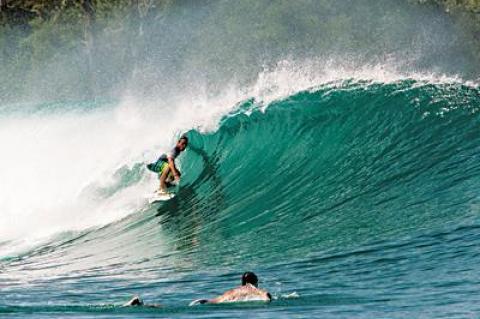 Indonesia: Montaukers’ Surfari
Indonesia: Montaukers’ SurfariNick Joeckel laughed, sort of, in telling how customs agents shook him down for two brand-new pairs of sunglasses in the Jakarta airport on the way back from a 10-day odyssey during which he surfed some of the best waves on the planet with 10 friends who had dreamed of surfing Indonesia together since they were kids.
They returned on June 22 bruised and cut from bouncing off the reefs of the Mentawai chain of islands, but with surfing batteries fully charged.
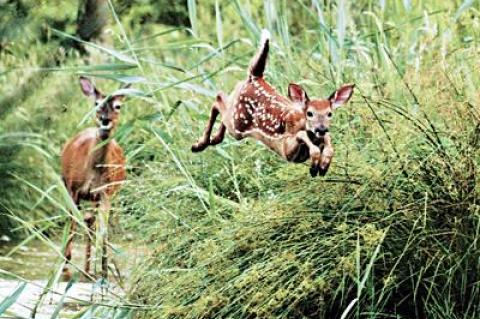 Nature Notes: The Deer Didn’t Do It
Nature Notes: The Deer Didn’t Do ItThe native deer population has been blamed for a lot of things, hosting ticks, causing highway accidents and vehicle damage, eating favorite ornamentals, even defecating on manicured lawns. For several years now deer have also been blamed for removing the underbrush or subshrub groundcover across the South Fork.
It’s a mixed up world, that’s for sure. There are some who have the point of view that world ethnic groups, world languages, world religions, and world nations shouldn’t be mixed up and homogenized in the same melting pot. Others say it’s inevitable, why fight it? The human being is one of the few species that is racing toward one cosmopolitan worldwide identity.
Twisted in rope and moving with difficulty, a leatherback turtle, estimated at 600 pounds, was rescued by the Riverhead Foundation for Marine Research and U.S. Coast Guard last Thursday.
The struggling turtle had been spotted in Gardiner’s Bay by a boater aboard the Madeline, from Quonset, R.I., who alerted Coast Guard Station Montauk, according to a statement released on Friday by the foundation.
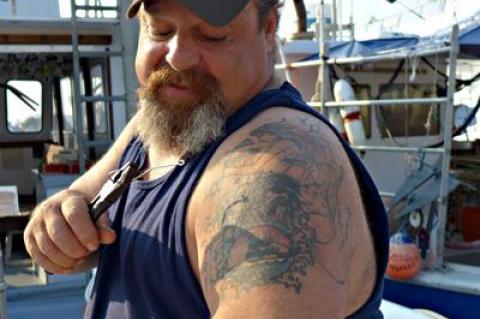 Wind From the West . . .
Wind From the West . . .What’s with the wind? It has come out of the west and southwest every day for the past two weeks now. A southwest wind prevails this time of year, but not at 20-knots plus, and not with so much accent on the westerly component. The pattern has kept small-boat operators at bay, especially in the afternoon.
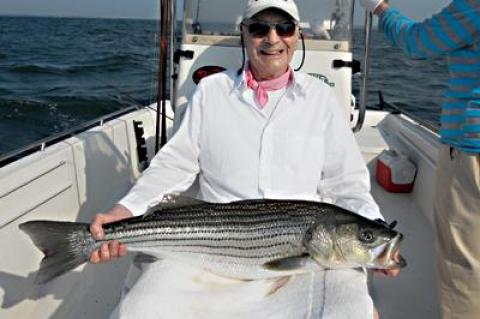 Lots of Fish and Lots of Fun
Lots of Fish and Lots of FunThe recent passing of the bayman Wayne Vorpahl at the age of 49 caused this observer to mourn the loss to the community of people whose lives and livelihoods depended on an understanding of nature’s rhythms.
Wayne knew where the clams were and why. He knew where the bass were and why. Same with crabs and oysters and striped bass and any of the creatures we share this place with.
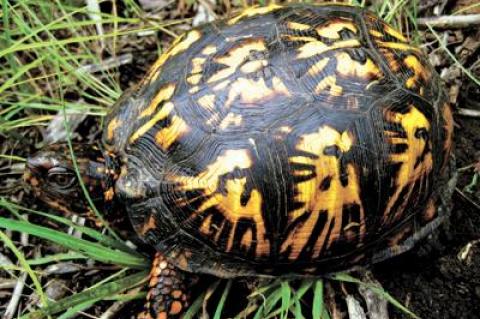 Nature Notes: Slow, Steady Decline
Nature Notes: Slow, Steady DeclineWhat happened to all the turtles? Of all the years since 1974 that I’ve been riding the roads and watching out for them, this is the year I’ve seen the fewest.
The two species that regularly cross roads in late May and June, the eastern box turtle and snapping turtle have been few and far between. I have yet to count a single turtle roadkill in 2013.
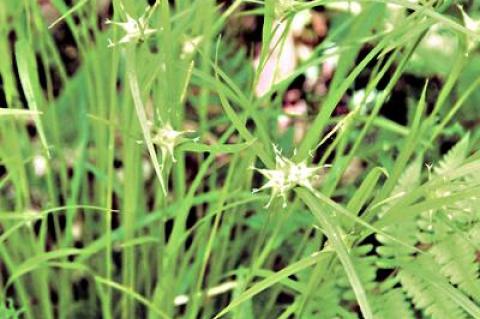 Nature Notes: Sedge Heaven
Nature Notes: Sedge HeavenThe Sunday Newsday crossword puzzle requested a five-letter word for “swamp plant.” I’ve been doing all of the Newsday and New York Times crosswords, seven days a week, since the early 1980s. In other words, I’ve done thousands of crosswords and saved them all.
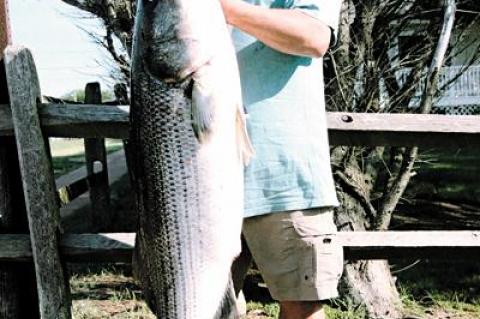 Till the Cows Come Home
Till the Cows Come Home“Moooooooooooo,” was what Brian Ritter heard when he answered the phone at 4 in the morning one week ago. He recognized the voice, and he needed no translation. It was Mike Coppola telling him he’d caught a big cow, a female of the species Morone saxatilis, a striped bass.
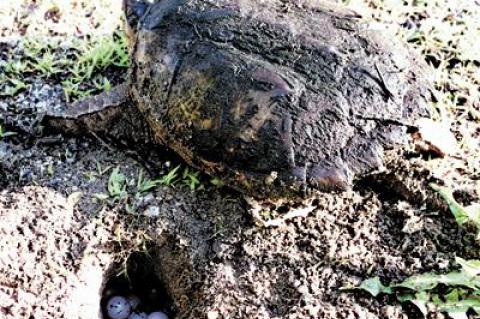 Nature Notes: The Point of a View
Nature Notes: The Point of a View“There’s a tree in the meadow with a stream drifting by.” Some of you may remember that song from the 1940s. It’s old, but the message is still good. The tree stands for constancy, the stream for the passage of time. It’s important to many of us to see that same tree over and over. We may even take it for granted, but when it’s cut down or blown down, we grieve its passing.
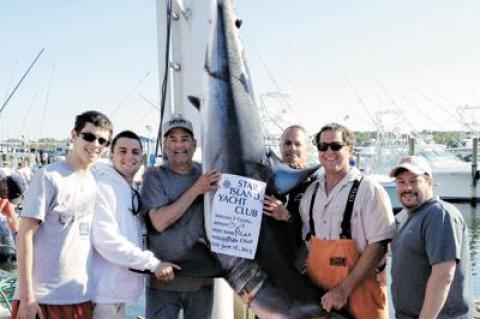 Quint and Huck Finn
Quint and Huck FinnFirst, the birds in the trees greeted the sun with song and chatter. A woodpecker hammered away on an old catalpa tree pregnant with its orchid-like blossoms. Then came the low drone of boats leaving Montauk Harbor.
It was 6 a.m. on the dot, the start time, the appointed hour of departure for the second day of the Star Island Yacht Club’s first shark tournament of the season, a type of derby that Capt. Frank Mundus, Montauk’s Monster Man and Peter Benchley’s model for Quint, the irascible charter captain in “Jaws,” declared vestigial years before he died back in ’08.
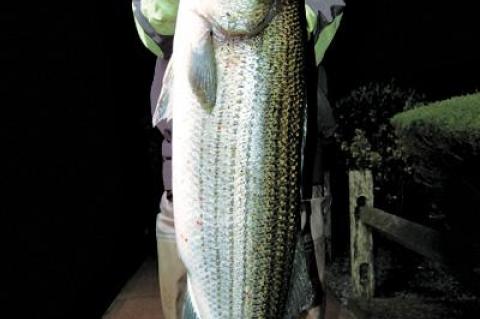 A Cautionary Tale
A Cautionary TaleOf course, the big news is the 44.7-pound striped bass that the surfcaster Ben McCarron caught on Saturday under the Montauk Lighthouse on a bucktail. The big bass puts McCarron in first place in the Montauk SurfMasters spring tournament, and the fish beat the competition in the weekend tournament held from Paulie’s Tackle Shop in Montauk.
Geoff Bowen’s 21.7-pound striper and Nick Tamorino’s 15.46-pounder stand in second and third places in the SurfMaster’s adult division. Brendan Ferrell leads the youth division with a 13.64-pound bass.
In many respects, sound and hearing in nature are just as important as sight. In those species that are more nocturnal than diurnal, sounds and the ability to hear, and differentiate, them is crucial to their survival. Whether an animal species is active in the day or at night, there’s a greater than 50 percent chance that it perceives sound waves or senses vibrations, another form of sound.
I heard my first whippoorwill in the woods behind my grandfather’s chicken farm in Mattituck at 3 years of age. Once you’ve heard this magical, three-syllable, eerie chant coming out of the dark of a warm summer evening you’re hard-pressed to forget it.
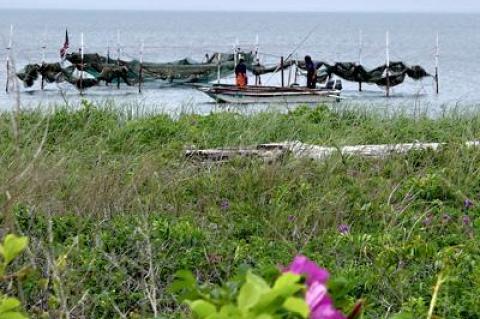 The Sweet Smell of Fish
The Sweet Smell of FishLet’s talk about the smell of fish. It’s often scorned, but the objectionable redolence is usually the result of proteins gone bad, spoiled. The truth is, fish fresh out of the water smell sweet, fish in the water sweeter still.
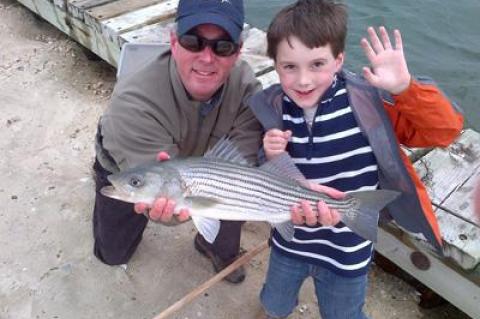 Moon Summoned Stripers
Moon Summoned StripersBruce Palmer oversees things at the East Hampton Town’s recycling center in Montauk, directing people with tires to the tire bin, people with old grills and lawnmowers to the metal container, checking for scofflaw dumpers dumping without benefit of a 2013 sticker — all these things with a mind that drifts seaward at times.
Sunday saw a break in the Memorial Day weekend weather. Downtown Montauk was jam-packed, a perfect time to escape into the deserted Montauk outback, as Vicki Bustamante and I are retracing Norman Taylor’s epic 1923 monograph on Montauk’s plants, “The Vegetation of Montauk: A Study of Grassland and Forest.”
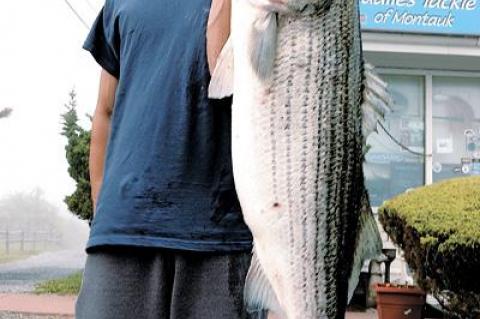 Montauk’s Mason-Dixon Line
Montauk’s Mason-Dixon LineMontauk is bipolar this time of year. When the summer’s southwesterly winds start to blow in May and early June, a Mason-Dixon line of sorts runs the length of the peninsula that is the east end of the South Fork.
The land south of the line is shrouded in thick, cold fog where the winter ocean first meets warm air blowing off the land west to east. North of the line, where the cold sea has less influence, the land is often bathed in warm sunlight.
I was at Morton Wildlife Refuge the other day when one of the private ferrying helicopters flew over on its way to East Hampton Town Airport. It’s hard to tell how high it was, but it seemed much lower than 2,000 feet and it made quite a racket as it passed over my head and, incidentally, over one of the osprey nests we put up around 1988 on the Jessup’s Neck spit. The ospreys were back. The female was sitting down low on the nest, and it was hard to tell if she was affected by the noise and vibrations as much as I was.
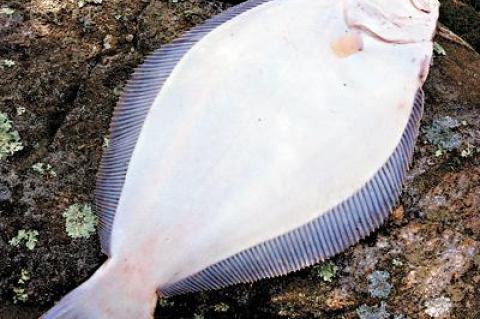 Spring Blooms, So Do Fish
Spring Blooms, So Do FishThe lilacs are in bloom, a sure sign that the fish local Indians called squeteague, and later dubbed tide runners, sea trout, or weakfish, have arrived right on their ancient schedule.
Spring is definitely here, there is no going back. The oaks, hickories, red maples, and sassafras are unfurling their leaves, March’s dull and dreary landscape is behind us. The month of May promises to delight all of our five senses, especially those that deal with vision, scents, and hearing. Helicopters and unmuffled motor vehicles be damned, we will not let them destroy our vernal pleasures.
